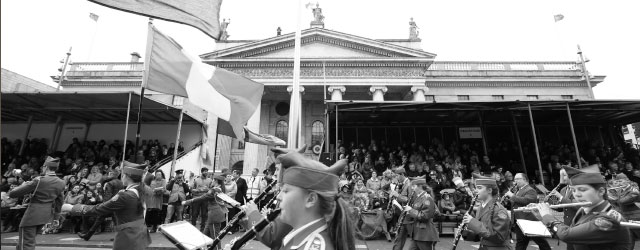Photo caption (above): In front of the GPO at St. Patrick’s Festival Parade
By Peter Makem
Back in the sixties I remember the St. Patrick’s day parade in Dublin as quite a solemn event with bands and procession marching through O’Connell Street. Then in 1996, the notion of the St Patrick’s Day Festival was launched and suddenly colour and extravaganza blossomed all over Dublin and this single day bloomed into a five-day celebration of everything that could be celebrated.
The parade had become international with a vengeance, miles of dragons and fantastic images and from somewhere amid the fantasia, St. Patrick himself always appeared, happy as ever, blessing all around him, waving to the masses as a global audience watched on and potential tourists thought — this is place to be!
In the twenty years since the nineties, the five-day spread became a tourist money spinner. Everything specifically Irish was on display, hotels flourished and so on. But just when people thought we had dregged the deeps of Irishness, of all that our culture could give, the notion of a month-long St. Patrick’s Festival has just taken root.

Apparently, as the thinking goes, Ireland’s cultural contribution to the world in literature and music and dance and painting is a much vaster subject than already stated. Then there is everything else, from holy wells to monastic sites, old castles, old prisons, lectures on thousands of related topics in what amounts to an annual international Month of Ireland extravaganza. Driven by the ever growing requirement for self worth, sense of destiny, a measure of escapism and the mystical sight of dollars pouring into the land, I strongly await this development.
Sometimes I wish St. Patrick had kept a diary and it had been found somewhere recently, totally intact and legible. I want to know he actually lived, his total human side. I want to read about his visit to Croagh Patrick — a mountain in Mayo later named in his honour — and his intention to spend Lent on top of it. Unfortunately, as the diary tells, he could only climb a few hundred feet as an old knee injury from his youth forced him to turn back. In fact, this injury was sustained on a early morning climb up Slemish in his days of slavery under Muilchu searching for lost sheep.
I want to read how, in fact, he didn’t immerse himself up to the knees for forty days and nights in Lough Derg as the story was passed on. He did admit he tried it but after a few hours in a bitter March day found his limbs grow senseless and was rescued by a travelling minstrel who brought him to his house and treated him for hypothermia, singing him back to full health.
I want to read about his oratorical powers, his political insight of converting the chieftains first and then approach the people, his actual imagery of the shamrock. I noticed there was no mention of snakes, but he did mention seeing Barbary apes which had been brought by sailors from Spain.
I also noticed that he spoke of having to hide from various enemies and of several attempts to force him to go back to England “where he came from” and to stop annoying the people. The diary revealed that he was quite a big man and had no problem looking after himself if physically attacked.
But entries show he was very intelligent in his mission and made sure that he did not dismiss the deep-rooted Celtic pagan beliefs but set them in a fresh context, preserving what was profound for the people and adding fresh profundity. But that bad knee did him no favours which is why he travelled by river and sea from place to place rather than land.
In vain I looked for a prophesy that one day there would be a whole month dedicated to his memory based in a city not yet built.

